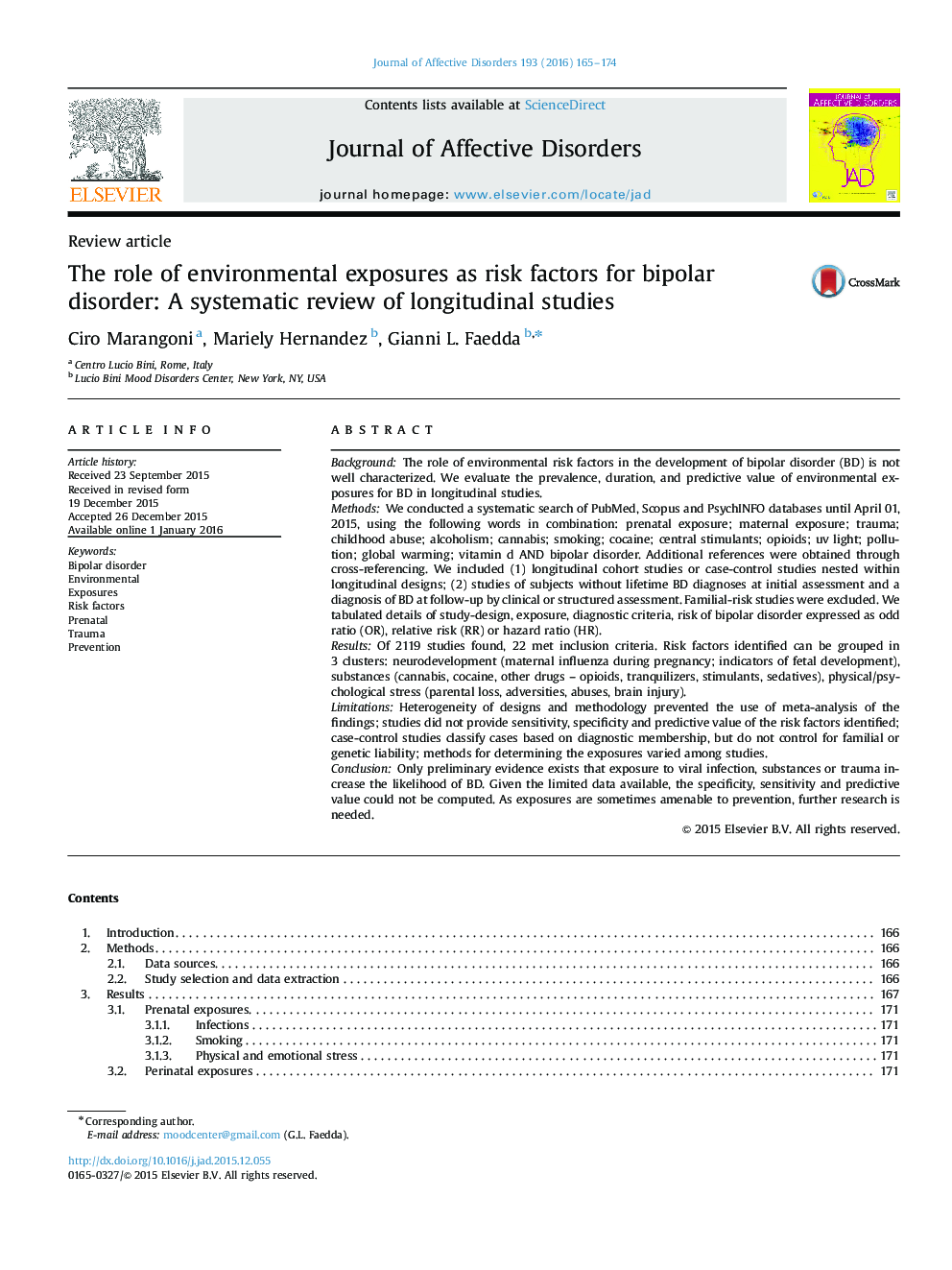| کد مقاله | کد نشریه | سال انتشار | مقاله انگلیسی | نسخه تمام متن |
|---|---|---|---|---|
| 6230456 | 1608132 | 2016 | 10 صفحه PDF | دانلود رایگان |
- Environmental risk factors identified can be grouped in 3 clusters: neurodevelopmental (maternal influenza during pregnancy; indicators of fetal development), substances (cannabis, cocaine, other drugs - opioids, tranquilizers, stimulants, and sedatives), physical/psychological stress (parental loss, adversities, abuses, and brain injury).
- Prenatal exposure to infections increases the risk of BD, but also of several other neuropsychiatric disorders including schizophrenia, autism and mental retardation. The exposure to influenza seems to be specific for psychotic bipolar I disorder, consistent with previous identified associations between exposure to prenatal influenza and schizophrenia. Interestingly, maternal exposure to influenza during the 2nd or 3rd trimesters increased the risk for MDD but not BD.
- Increased maternal stress during pregnancy has been associated with different psychiatric disorders, from schizophrenia, depression, anxiety as well as autism and attention deficit hyperactivity disorder. Prenatal (1st trimester) stress-exposure increased the risk for BD, while postnatal stress (0-2 yrs) increased the offspring's risk of suicide-attempted and completed-but not mood disorders.
- Substance abuse often precedes the onset of BD in many patients. Cannabis increases the rate of BD conversion in patients with major depressive episodes, and anticipates the age of onset of BD. Cocaine use increased the risk of BD in the Epidemiologic Catchment Area prospective study; the association has been confirmed in the National Epidemiologic Survey study, both for cocaine and stimulant abuse and dependence.
BackgroundThe role of environmental risk factors in the development of bipolar disorder (BD) is not well characterized. We evaluate the prevalence, duration, and predictive value of environmental exposures for BD in longitudinal studies.MethodsWe conducted a systematic search of PubMed, Scopus and PsychINFO databases until April 01, 2015, using the following words in combination: prenatal exposure; maternal exposure; trauma; childhood abuse; alcoholism; cannabis; smoking; cocaine; central stimulants; opioids; uv light; pollution; global warming; vitamin d AND bipolar disorder. Additional references were obtained through cross-referencing. We included (1) longitudinal cohort studies or case-control studies nested within longitudinal designs; (2) studies of subjects without lifetime BD diagnoses at initial assessment and a diagnosis of BD at follow-up by clinical or structured assessment. Familial-risk studies were excluded. We tabulated details of study-design, exposure, diagnostic criteria, risk of bipolar disorder expressed as odd ratio (OR), relative risk (RR) or hazard ratio (HR).ResultsOf 2119 studies found, 22 met inclusion criteria. Risk factors identified can be grouped in 3 clusters: neurodevelopment (maternal influenza during pregnancy; indicators of fetal development), substances (cannabis, cocaine, other drugs - opioids, tranquilizers, stimulants, sedatives), physical/psychological stress (parental loss, adversities, abuses, brain injury).LimitationsHeterogeneity of designs and methodology prevented the use of meta-analysis of the findings; studies did not provide sensitivity, specificity and predictive value of the risk factors identified; case-control studies classify cases based on diagnostic membership, but do not control for familial or genetic liability; methods for determining the exposures varied among studies.ConclusionOnly preliminary evidence exists that exposure to viral infection, substances or trauma increase the likelihood of BD. Given the limited data available, the specificity, sensitivity and predictive value could not be computed. As exposures are sometimes amenable to prevention, further research is needed.
Journal: Journal of Affective Disorders - Volume 193, 15 March 2016, Pages 165-174
